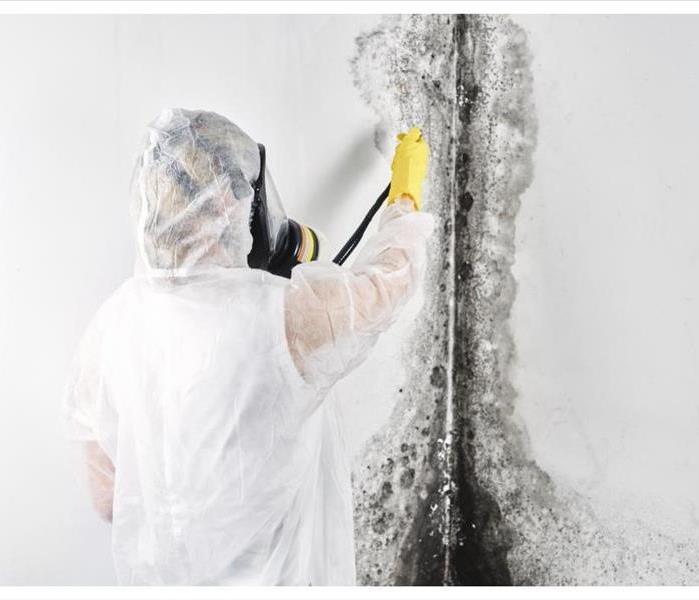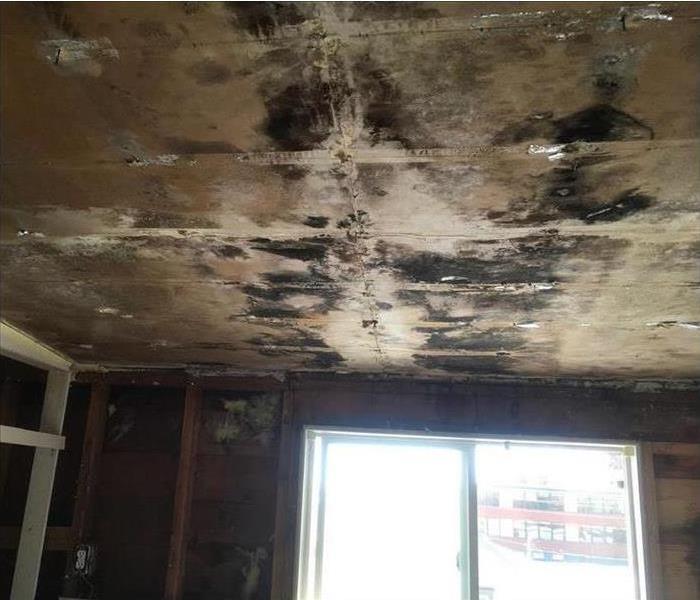Archived Mold Remediation Blog Posts
What Personal Protective Equipment is Needed for Mold Removal?
5/11/2020 (Permalink)
 Personal protective equipment keeps a mold remediation team safe
Personal protective equipment keeps a mold remediation team safe
Types of Mold Cleanup PPE
When cleaning mold growth, the first priority is to protect everyone. Personal protective equipment keeps a mold remediation team safe while helping to prevent cross-contamination. The main types of mold cleanup PPE are:
1. Hair Cover
If mold spores settle in your hair, they can easily be transferred throughout the building or inhaled. When taking a break, the hair cover in use should be disposed of and a new one put on before work resumes.
2. Face Mask
An air-purifying respirator needs to be worn during mold cleanup. An N-95 mask will filter out 95% of all particles and is usually fine for this work. You can get disposable or reusable. Either way, it needs to be removed before leaving the affected area and replaced when returning to work.
3. Safety Goggles
Thorough mold cleanup usually means a lot of debris in the air (e.g., mold spores, dirt, dust and drywall). Safety goggles protect the eyes from debris and harsh chemicals.
4. Gloves
It’s important to wear form-fitting disposable gloves; mold spores can get inside ill-fitting gloves. The gloves should be removed between work sessions before leaving the affected area, and replaced with new ones upon return.
5. Protective Coverall
Tyvek suits are preferable for mold remediation since they’re disposable. This type of suit can be worn over regular clothes and disposed of once work is completed. Unprotected street clothing should be changed just after leaving the affected area and washed in hot water.
6. Shoe Covers
Just like the disposable gloves and hair covers, disposable shoe covers should be removed and disposed of when taking a break from work. Then, a new pair should be worn when returning to work.
It’s important to protect people and uncontaminated areas from exposure to mold. If your building in Laurel, MT, suffers mold damage, mold remediation professionals will restore it to its preloss condition as soon as possible.
Black Mold Prevention and Remediation Tips for Homeowners
5/30/2019 (Permalink)
 Mold on ceiling from water loss
Mold on ceiling from water loss
Black Mold Prevention and Remediation
When you notice signs of mold growth in your home, it’s often necessary to have a mold inspection in your home. Though mold is a common problem many homeowners in Broadview, MT, encounter, there are several prevention and remediation tips that can be useful.
1. Know the Signs of Mold Damage
In order to mitigate mold damage in your home, it can be useful to know early signs of mold growth. Mold can start to grow within 24-48 hours after water damage has occurred. Early signs of house mold growth may include discoloration on a surface. Additionally, many types of mold are often described as having an unpleasant musty odor.
2. Be Able to Identify the Appearance of Mold
Although many people may think that their homes do not have black mold, also known as Stachybotrys, present if the mold is not black in color, this isn’t always the case. Stachybotrys can vary greatly in appearance, and it can be unsafe to assume that mold that is gray or white in color isn’t hazardous. Additionally, knowing that Stachybotrys can vary in texture, appearing either smooth or fuzzy, texture of mold can help you identify the type of mold present in your home.
3. Know When to Employ Professionals
Taking steps to prevent mold can be useful, but a mold inspection is often needed when a home has major mold damage or if the type of mold present could be hazardous. Homes that have recently sustained water damage are often prone to mold growth, and it can be helpful to contact mold remediation specialists who can thoroughly inspect your home for signs of mold damage. However, widespread damage can also occur over time, and if you notice signs of mold growth throughout your home, you may also want to consider having your home inspected.
Many homeowners notice mold in their homes at one time. It’s often valuable for homeowners to know how to prevent mold growth, how to identify black mold and when a mold inspection done by professionals may be useful.
6 Steps in the Mold Remediation Process
2/19/2018 (Permalink)
Are you nervous about an upcoming mold remediation in Billings, MT? Whether you have black mold or a lesser known variation, fungus growth can cause a lot of stress for business owners. You can review these six common steps to make yourself feel better about your upcoming mold cleanup.
1. Call in Professionals. When you call in a commercial remediation team, they will be able to inspect and assess your building. This will allow them to come up with a unique plan that best suits your mold problem.
2. Start Mold Containment. Setting up barriers and HEPA filters can help keep the mold in an isolated area. Your remediation team may even install a negative air chamber to help with the containment of the black mold.
3. Wear Personal Protective Equipment. While you should try not to spend much time in the affected area, whenever you do go in the mold zone you should be wearing personal protective equipment. The professionals often wear masks, gloves and disposable suits to limit the contact with spores.
4. Remove Porous Materials. Drywall, flooring and other porous materials may have to be ripped out of your building to ensure the mold is completely removed. Even some furnishings may have to be thrown out.
5. Clean Other Items. Items that do not get waterlogged easily can be cleaned and disinfected rather than thrown away. You may have to clean some items on your own, but typically the cleaning and disinfecting will be a major part of the remediation process.
6. Make Repairs. After the mold has been removed, the team may make repairs to drywall and flooring to finish off the cleanup process. Repairs can also include the drying out of wet materials to ensure mold does not come back.
The mold remediation process does not always follow these exact steps. Professionals in Billings, MT, may have to expand their mold cleanup strategy when dealing with certain types of fungus, such as black mold.
For more information, visit http://www.SERVPRObillings.com.




 24/7 Emergency Service
24/7 Emergency Service

